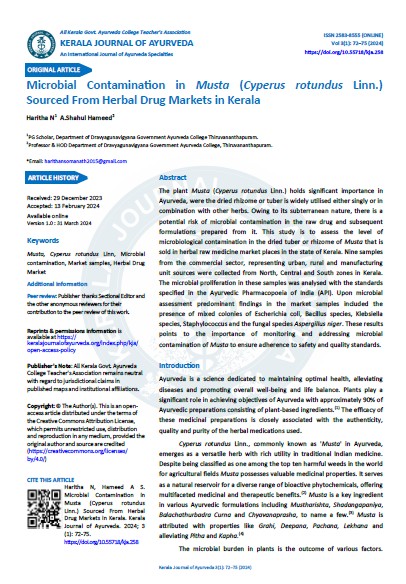Microbial Contamination in Musta (Cyperus rotundus Linn.) Sourced From Herbal Drug Markets in Kerala
DOI:
https://doi.org/10.55718/kja.258Keywords:
Musta, Cyperus rotundus Linn, Microbial contamination, Market samples, Herbal Drug MarketAbstract
The plant Musta (Cyperus rotundus Linn.) holds significant importance in Ayurveda, were the dried rhizome or tuber is widely utilised either singly or in combination with other herbs. Owing to its subterranean nature, there is a potential risk of microbial contamination in the raw drug and subsequent formulations prepared from it. This study is to assess the level of microbiological contamination in the dried tuber or rhizome of Musta that is sold in herbal raw medicine marketplaces in the state of Kerala. Nine samples from the commercial sector, representing urban, rural, and manufacturing unit sources, were collected from North Central and South zones in Kerala. The microbial proliferation in these samples was analysed with the standards specified in the Ayurvedic Pharmacopoeia of India (API). Upon microbial assessment, predominant findings in the market samples included the presence of mixed colonies of Escherichia coli, Bacillus species, Klebsiella species, Staphylococcus, and the fungal species Aspergillus niger. These results points to the importance of monitoring and addressing microbial contamination of Musta to ensure adherence to safety and quality standards.
References
Kumar S, Dobos GJ, Rampp T. The Significance of Ayurvedic Medicinal Plants. Journal of Evidence-based Complementary & Alternative Medicine. 2017 Jul;22(3):494.
Dhar P, Dhar D, Rawat A, Srivastava S. Medicinal chemistry and biological potential of Cyperus rotundus Linn.: An overview to discover elite chemotype(s) for industrial use. Industrial Crops and Products. 2017 Dec 1;108:232–47.
Government of India , Ministry Of Health and Welfare. The Ayurvedic Pharmacopoeia of India. Vol. Part 1 Volume 6. Department of Ayush; CCCI to CCCXIV.
Amritpal singh. Bhavaprakasha Nighantu. first. Varanasi: Chaukhambha Orientalia; 2007. 66 p. (Kashi Ayurveda Series).
Araújo MG de F, Bauab TM, Araújo MG de F, Bauab TM. Microbial Quality of Medicinal Plant Materials. In: Latest Research into Quality Control *Internet+. IntechOpen; 2012 *cited 2023 Nov 25+.
Available from: https://www.intechopen.com/chapters/38511
Gupta KK, Prasad G, Chopra AK, Khanna DR. Contamination of Asian herbal drugs : Need for its critical evaluation. Journal of Applied and Natural Science. 2009 Dec 1;1(2):291–7.
Gautam A, Sharma S, Bhadauria R. Detection of toxigenic fungi and mycotoxins in medicinally important powdered herbal drugs. Internet Journal of Microbiology. 2010 Jan 1;7.
Bennett JW, Klich M. Mycotoxins. Clin Microbiol Rev. 2003 Jul;16 (3):497–516.
Qiu Y, Zhou Y, Chang Y, Liang X, Zhang H, Lin X, et al. The Effects of Ventilation, Humidity, and Temperature on Bacterial Growth and Bacterial Genera Distribution. Int J Environ Res Public Health. 2022 Nov 20;19(22):15345.





